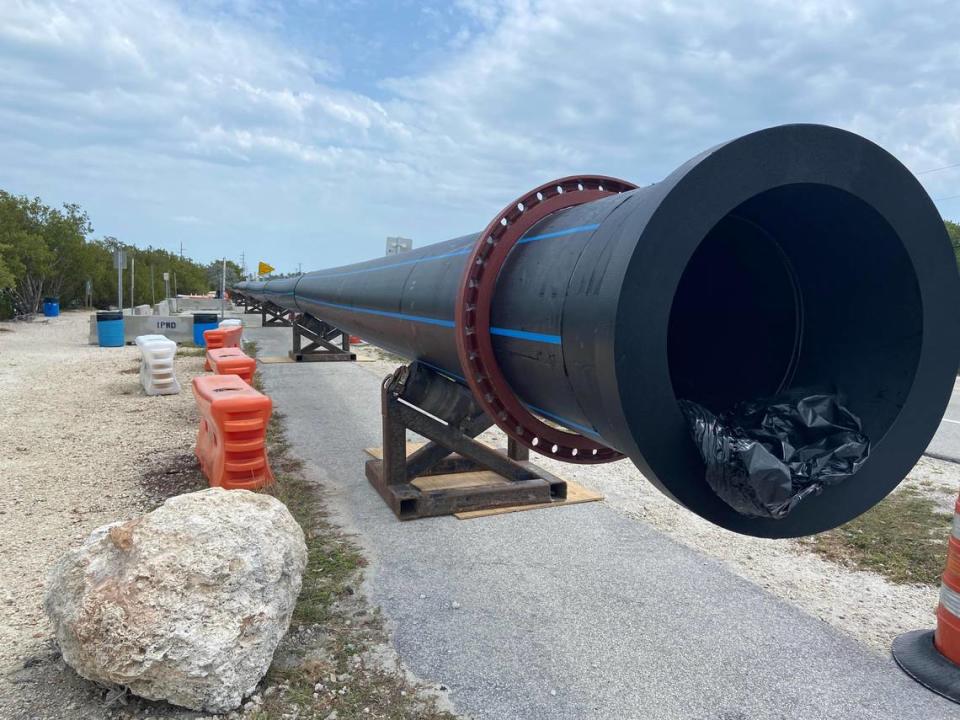Three Florida Keys water main pipes burst in a week. The state is now investigating
The state’s main environmental enforcement agency this month informed the Florida Keys’ water utility that it’s under investigation for failing to maintain aging underground pipes, according to a letter obtained by the Miami Herald.
The deteriorating state of the pipes resulted in three breaks in one week in March, disrupting traffic and temporarily cutting off water to the island chain, where residents, businesses and tourists continue to be asked to conserve usage.
The 40-year-old system is the only means of piping freshwater throughout the 120-mile archipelago.
The letter comes two months after the disrupting water main breaks. Greg Veliz, executive director of the Florida Keys Aqueduct Authority, said replacing all the underground pipes would cost more than $1 billion — and the utility didn’t have that money in reserves.
“Every day, we talk about funding. Whether it be from our grant writers, our lobbyists, whether it be from our finance department, seeing if we can get low-interest loans; we’re exercising every possibility in order to try to get funding for this project,” Veliz said in an interview with the Miami Herald/FLKeysnews.com.
The May 5 letter states the the Florida Keys Aqueduct Authority is in violation of state statute because it “failed to maintain its system in good operating condition so as to function as intended.”
The water utilty also “has known for some time that there is a desperate need for the transmission main,” wrote Jason Andreotta, southeast district director of the Florida Department of Environmental Protection.
The cause of the pipe breaks, according to the letter, is “a very deteriorating water system that has not undergone assessment until recent years.”
Andreotta added a reverse osmosis desalinization plant on Stock Island in the Lower Keys, which augments the fresh water supply that comes from the mainland in Florida City, is also deteriorating.
Florida agency vs. Keys utility
Veliz on Thursday said the Aquaduct Authority received the letter, but called it “a breakdown in communications” between the utility and the state agency he thinks will soon get resolved.
“They didn’t have the right information in front of them at the time, and we believe they have that now,” Veliz said. “But, we have not received a response.”
Jon Moore, a spokesman for the state environmental protection agency, said the letter was issued “as the first step in our enforcement process and requires the FKAA to develop a structured path towards a timely and thorough rehabilitation of their drinking water infrastructure.”
The letter states the investigation could result in liability for damages and the judicial imposition of civil penalties.
The state agency “will continue its stringent oversight to ensure the remaining repairs are conducted in a thorough but expeditious manner so that residents have access to a restored, fully functioning drinking water system as soon as possible,” Moore said.
The Florida Keys Aqueduct Authority is in the process of restoring five miles of pipe in the Upper Keys Village of Islamorada.
Veliz said the $42 million project is ahead of schedule since it got underway in April. The scheduled completion date is February 2025 and is being funded with $35 million in grants and $7 million in low-interest loans, the utility said in a statement.

What about the Aqueduct Authority money reserves?
Veliz, on the job for two years, says doesn’t know why the utility doesn’t have more money in reserves.
“For me to sit down and play Monday morning quarterback and say why we don’t have the funding available, I don’t know how you would be able to accumulate a million dollars, first of all, and, let me tell you, there would be no way to foresee that anyway,” he said. “It’s impossible to sit here now and try to make assumptions about what happened and why wasn’t funding put aside.”
He also said that since the Islamorada project was in its planning phase, costs have risen significantly.
“From the time we started planning this project in 2017 to the time we got shovels in the ground and a contract on board, the price has gone from $5 million per mile to $8 to $10 million a mile,” Veliz said. “So, there’s no way we could have foreseen that anyway.”

